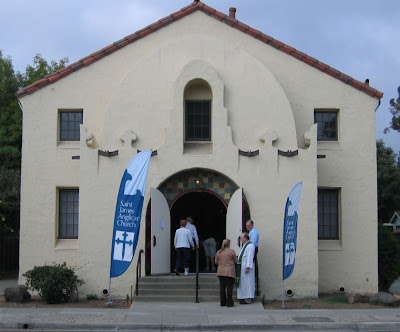While a few of the Schism I crowd left ECUSA with their property, before the Dennis Canon, and a few parishes (and three diocese) are in court to keep the facilities they owned prior to the split — the reality is that many Schism II parishes left with only their people and a great deal of hope. These parishes have been renting other churches (off peak), schools, community centers or other meeting space. (Such rented facilities were also the norm for other new church plants for decades.)
Today St. James of San Jose completed what must have been one of the quickest ACNA journeys in the wilderness, as they celebrated their first day worshiping in their own sanctuary. The parish was formed by ECUSA refugees in March 2009 from St. Edwards, the last evangelical parish in the Diocese of El Camino Real (headed by a Nashotah House grad).
The parish spend the intervening months renting space at San Jose and Saratoga community centers, pioneering the “church in a box” weekly setup process.
The new sanctuary was formerly a small community church in Willow Glen, that had largely sat empty since its pastor retired. St. James visited the parish in Spring 2010, then forgot about it until it was offered the parish again this summer — with the owners generously selling at a price far under market.
St. James held its first two services at the parish on Sunday — the 9:00 am Rite I with hymns and the 10:30 Rite II with rock band. Having a sanctuary solves the problem of midweek services, including Ash Wednesday, Good Friday and Christmas.
Five miles from their former St. Edwards home, the new location puts the ACNA back in Northern California's most populous city, as part of Father Ed McNeill's efforts to build for ACNA a Diocese of San Francisco Bay. It also allows Rev. McNeill and others to focus on planting additional ACNA parishes in Northern California, and to help those parishes gain their own permanent church facilities.
Raising Up Liturgical Leaders
-
SALLY MESSNER -- With fewer trained musicians engaged regularly in church
communities, its time to get creative and collaborative about how we engage
and...
1 week ago

